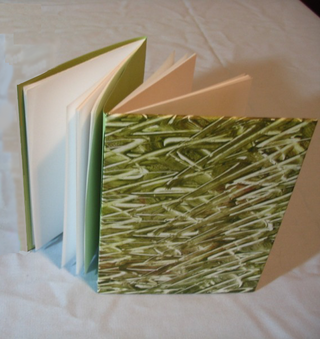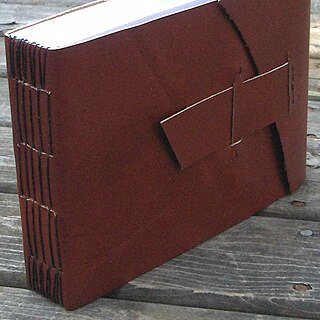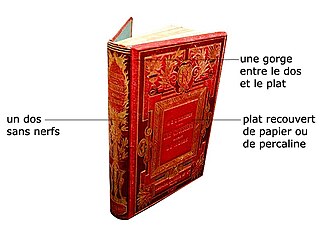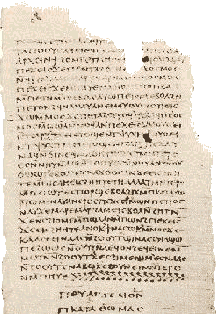
The codex was the historical ancestor of the modern book. Instead of being composed of sheets of paper, it used sheets of vellum, papyrus, or other materials. The term codex is often used for ancient manuscript books, with handwritten contents. A codex, much like the modern book, is bound by stacking the pages and securing one set of edges by a variety of methods over the centuries, yet in a form analogous to modern bookbinding. Modern books are divided into paperback and those bound with stiff boards, called hardbacks. Elaborate historical bindings are called treasure bindings. At least in the Western world, the main alternative to the paged codex format for a long document was the continuous scroll, which was the dominant form of document in the ancient world. Some codices are continuously folded like a concertina, in particular the Maya codices and Aztec codices, which are actually long sheets of paper or animal skin folded into pages. In Japan, concertina-style codices called orihon developed during the Heian period (794–1185) were made of paper.

The Nag Hammadi library is a collection of early Christian and Gnostic texts discovered near the Upper Egyptian town of Nag Hammadi in 1945.

A scroll, also known as a roll, is a roll of papyrus, parchment, or paper containing writing.
The Berlin Codex, given the accession number Papyrus Berolinensis 8502, is a Coptic manuscript from the 5th century CE, unearthed in Akhmim, Egypt. In Cairo, in January 1896, Carl Reinhardt bought the codex, which had been recently discovered, wrapped in feathers, in a niche in a wall at a Christian burial site. It was a papyrus bound book, dating to early 5th century that was written in Sahidic dialect of Coptic, which was in common use in Egypt during that time.

The Apocryphon of John, also called the Secret Book of John or the Secret Revelation of John, is a 2nd-century Sethian Gnostic Christian pseudepigraphical text attributed to John the Apostle. It is one of the texts addressed by Irenaeus in his Against Heresies, placing its composition before 180 AD. It is presented as describing Jesus appearing and giving secret knowledge (gnosis) to his disciple John. The author describes it as having occurred after Jesus had "gone back to the place from which he came".

A treasure binding or jewelled bookbinding is a luxurious book cover using metalwork in gold or silver, jewels, or ivory, perhaps in addition to more usual bookbinding material for book covers such as leather, velvet, or other cloth. The actual bookbinding technique is the same as for other medieval books, with the folios, normally of vellum, stitched together and bound to wooden cover boards. The metal furnishings of the treasure binding are then fixed, normally by tacks, onto these boards. Treasure bindings appear to have existed from at least Late Antiquity, though there are no surviving examples from so early, and Early Medieval examples are very rare. They were less used by the end of the Middle Ages, but a few continued to be produced in the West even up to the present day, and many more in areas where Eastern Orthodoxy predominated. The bindings were mainly used on grand illuminated manuscripts, especially gospel books designed for the altar and use in church services, rather than study in the library.
Codex Tchacos is an ancient Egyptian Coptic papyrus, which contains early Christian gnostic texts from approximately 300 AD: the Letter of Peter to Philip, the First Apocalypse of James, the Gospel of Judas, and a fragment of the Book of Allogenes.

A bookmark is a thin marking tool, commonly made of card, leather, or fabric, used to keep track of a reader's progress in a book and allow the reader to easily return to where the previous reading session ended. Alternate materials for bookmarks are paper, metals like silver and brass, silk, wood, cord (sewing), and plastic. Some books may have one or more bookmarks made of woven ribbon sewn into the binding. Furthermore, other bookmarks incorporate a page-flap that enables them to be clipped on a page.

In bookbinding, a dos-à-dos binding is a binding structure in which two separate books are bound together such that the fore edge of one is adjacent to the spine of the other, with a shared lower board between them serving as the back cover of both. When shelved, the spine of the book to the right faces outward, while the spine of the book to the left faces the back of the shelf; the text of both works runs head-to-tail.

In the art of bookbinding, the longstitch technique is used for binding the sections (signatures) of a book without using glue. In Non-adhesive Binding: Books without Paste of Glue (1999) Keith A. Smith describes that binding a book with a "longstitch through a slotted cover" involves directly sewing each section through the cover, which has slots for attaching each section, and creates a pattern of staggered lines that is visible on the spine of the book.

In bookbinding, finishing refers to the process of decorating the outside of a book, including the lettering of the spine and covers, any additional tooling, and any inlays and onlays. Finishing can also include the gilding or other decoration of the edges of the book's pages.

In bookbinding, a section, gathering, or signature is a group of sheets folded in half, to be worked into the binding as a unit.
The Ethiopian bookbinding technique is a chain stitch sewing that looks similar to the multi section Coptic binding method. According to J. A. Szirmai, the chain stitch binding dates from about the sixteenth century in Ethiopia and Eritrea. These books typically had paired sewing stations, sewn using two needles for each pair of sewing stations. The covers were wooden and attached by sewing through holes made into edge of the board. Most of these books were left uncovered without endbands.

Limp binding is a bookbinding method in which the book has flexible cloth, leather, vellum, or (rarely) paper sides. When the sides of the book are made of vellum, the bookbinding method is also known as limp vellum.

Bookbinding is the process of building a book, usually in codex format, from an ordered stack of paper sheets with one's hands and tools, or in modern publishing, by a series of automated processes. Firstly, one binds the sheets of papers along an edge with a thick needle and strong thread. One can also use loose-leaf rings, binding posts, twin-loop spine coils, plastic spiral coils, and plastic spine combs, but they last for a shorter time. Next, one encloses the bound stack of paper in a cover. Finally, one places an attractive cover onto the boards, and features the publisher's information and artistic decorations.
Codex Bodmer XIX is a Coptic uncial manuscript of the four Gospels, dated palaeographically to the 4th or 5th century. It contains the text of the Gospel of Matthew 14:28-28:20; Epistle to the Romans 1:1-2:3. It is written in the Sahidic dialect of the Coptic language.
Stephen Emmel is a Coptologist and musician.

A Bradel binding is a style of book binding with a hollow back. It most resembles a case binding in that it has a hollow back and visible joint, but unlike a case binding, it is built up on the book. Characteristic of the binding is that the material covering the outside boards is separate from that covering the spine. Many bookbinders consider the Bradel binding to be stronger than the Case binding.

Nag Hammadi Codex II is a papyrus codex with a collection of early Christian Gnostic texts in Coptic. The manuscript has survived in nearly perfect condition. The codex is dated to the 4th century. It is the only complete manuscript from antiquity with the text of the Gospel of Thomas.
Nag Hammadi Codex XIII is a papyrus codex with a collection of early Christian Gnostic texts in Coptic. The manuscript is generally dated to the 4th century, though there is some debate regarding the original composition of the texts.















